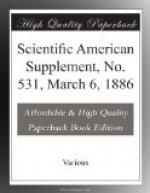Stations wholly magnetic may be established by adding to the transmitter and two receivers a Sieur phonic call, which will actuate them powerfully, and cause them to produce a noise loud enough for a call. It would be interesting to try this telephone on a city line, and to a great distance on those telegraph lines that are provided with the Van Rysselberghe system. Excellent results would certainly be obtained, for, as we have recently been enabled to ascertain, the voice has a remarkable intensity in this telephone, while at the same time perfectly preserving its quality.—La Nature.
* * * * *
[NATURE.]
THE MELDOMETER.
The apparatus which I propose to call by the above name ([mu][epsilon][lambda][delta][omega], to melt) consists of an adjunct to the mineralogical microscope, whereby the melting-points of minerals may be compared or approximately determined and their behavior watched at high temperatures either alone or in the presence of reagents.
As I now use it, it consists of a narrow ribbon of platinum (2 mm. wide) arranged to traverse the field of the microscope. The ribbon, clamped in two brass clamps so as to be readily renewable, passes bridgewise over a little scooped-out hollow in a disk of ebony (4 cm. diam.). The clamps also take wires from a battery (3 Groves cells); and an adjustable resistance being placed in circuit, the strip can be thus raised in temperature up to the melting-point of platinum.
The disk being placed on the stage of the microscope the platinum strip is brought into the field of a 1” objective, protected by a glass slip from the radiant heat. The observer is sheltered from the intense light at high temperatures by a wedge of tinted glass, which further can be used in photometrically estimating the temperature by using it to obtain extinction of the field. Once for all approximate estimations of the temperature of the field might be made in terms of the resistance of the platinum strip, the variation of such resistance with rise of temperature being known. Such observations being made on a suitably protected strip might be compared with the wedge readings, the latter being then used for ready determinations. Want of time has hindered me from making such observations up to this.
The mineral to be experimented on is placed in small fragments near the center of the platinum ribbon, and closely watched while the current is increased, till the melting-point of the substance is apparent. Up to the present I have only used it comparatively, laying fragments of different fusibilities near the specimen. In this way I have melted beryl, orthoclase, and quartz. I was much surprised to find the last mineral melt below the melting-point of platinum. I have, however, by me as I write, a fragment, formerly clear rock-crystal, so completely fused that between crossed Nicols it behaves as if an amorphous body, save in the very center where a speck of flashing color reveals the remains of molecular symmetry. Bubbles have formed in the surrounding glass.




